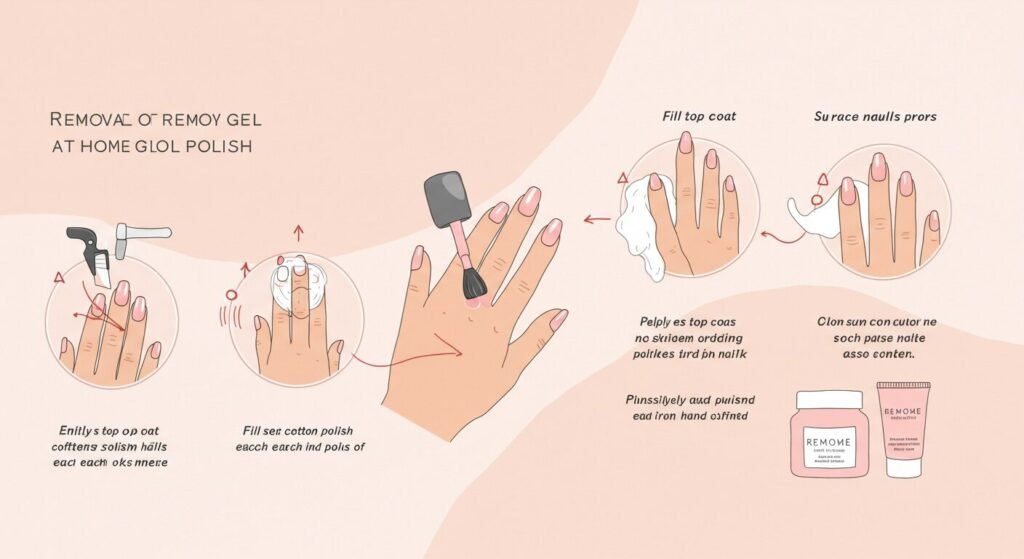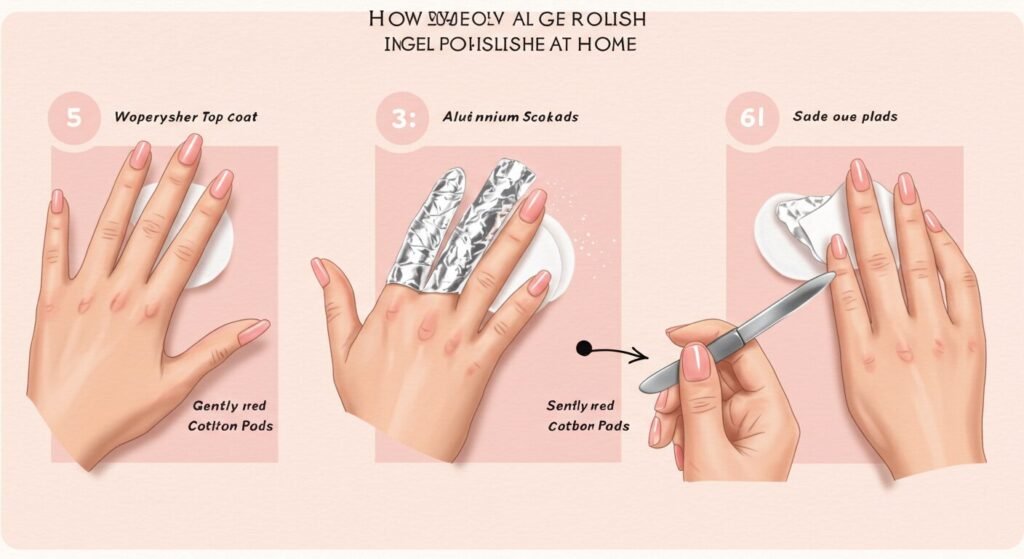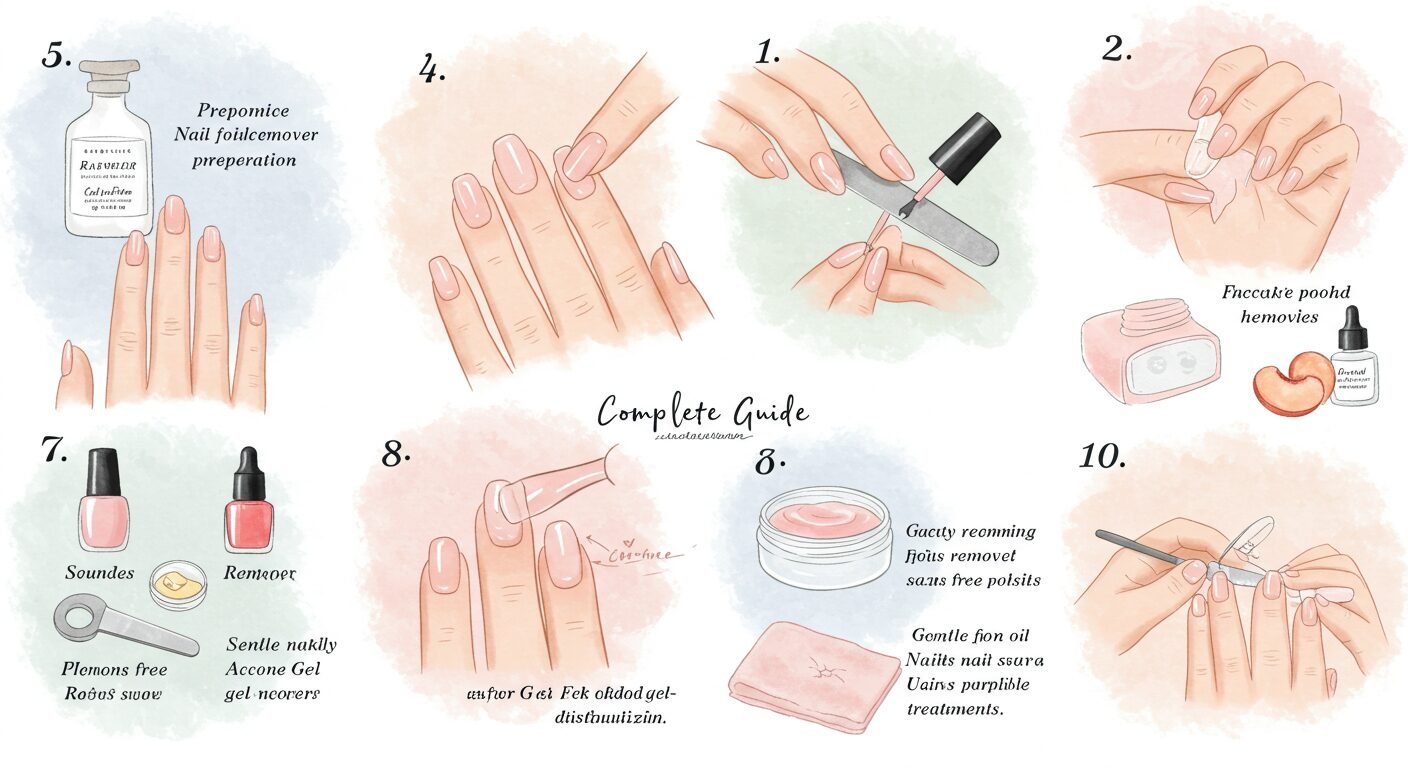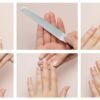Are you staring at your beautiful gel manicure wondering how to remove it without destroying your natural nails? You’re not alone! Learning how to remove gel nail polish properly is essential for maintaining healthy nails while transitioning between manicures or taking a break from gel applications.
Gel nail polish removal might seem intimidating, but with the right techniques and tools, you can safely remove even the most stubborn gel polish at home. Whether your gel manicure is chipping, overgrown, or you simply want a change, proper gel polish removal methods protect your natural nails from damage while preparing them for their next beautiful look.
In this comprehensive guide, we’ll explore professional-grade techniques, safe DIY methods, and essential aftercare steps that ensure your nails remain healthy and strong throughout the removal process and beyond.
Understanding Gel Nail Polish Structure
What Makes Gel Polish Different
Gel nail polish composition differs significantly from regular lacquer, containing photoinitiators that cure under UV or LED light to create a hard, durable finish. Gel polish chemistry involves polymer chains that cross-link during curing, creating the long-lasting wear that makes gel manicures so popular.
Cured gel structure becomes significantly more resistant to traditional polish removers, requiring specific techniques and stronger solvents for effective removal. Gel polish layers typically include base coat, color coats, and top coat, each contributing to the overall durability and removal complexity.
Chemical bonding in gel polish creates adhesion that’s much stronger than regular polish, explaining why simple acetone soaking often isn’t sufficient for complete removal without proper technique and patience.
Why Proper Removal Matters
Nail damage prevention becomes crucial when removing gel polish, as improper techniques can cause peeling, thinning, or weakening of natural nail plates. Forceful removal risks tearing away layers of natural nail along with the gel coating.
Long-term nail health depends on gentle removal practices that preserve nail integrity for future manicures. Professional techniques minimize trauma while ensuring complete product removal that prevents lifting or bacterial growth.
Preparation for future applications requires clean, healthy nail surfaces free from residual gel particles or damage that could compromise adhesion of subsequent manicures.
Essential Tools and Supplies
Professional-Grade Removal Tools
Acetone nail polish remover forms the foundation of effective gel removal, with pure acetone proving most efficient for breaking down cured gel polymers. High-quality acetone dissolves gel polish more quickly than weaker formulations, reducing exposure time and potential damage.
Aluminum foil wraps create the occlusive environment necessary for effective acetone penetration and gel softening. Cotton balls or pads hold acetone against nail surfaces during the soaking process, ensuring consistent contact and saturation.
Cuticle pushers help gently remove softened gel without forcing or scraping that could damage natural nails. Nail files in various grits prepare gel surfaces for removal and smooth nails afterward.
Additional Helpful Supplies
Hand cream or cuticle oil provides essential moisture replacement after acetone exposure, which can be very drying to skin and nails. Nail buffer helps smooth any rough spots remaining after gel removal.
Small glass bowls work better than plastic for acetone soaking, as acetone can dissolve some plastic containers. Timer ensures proper soaking duration without over-exposure to harsh chemicals.
Good lighting helps identify remaining gel particles and ensures thorough removal. Ventilation is essential when working with acetone to prevent inhalation and ensure comfort during the process.
Step-by-Step Professional Removal Method

Preparation Phase
Workspace setup should include good ventilation, adequate lighting, and protection for surrounding surfaces from acetone spills. Hand preparation involves washing and drying thoroughly to remove oils or lotions that might interfere with removal.
Nail trimming to manageable length makes the removal process easier and reduces the amount of gel requiring dissolution. Surface roughing with a coarse file breaks the top coat seal, allowing acetone to penetrate more effectively.
Cuticle protection using petroleum jelly or cuticle oil around nail edges prevents acetone from over-drying surrounding skin during the soaking process.
Soaking and Removal Process
Acetone application involves saturating cotton balls and placing them directly on each nail, ensuring complete coverage of the gel surface. Foil wrapping each fingertip creates the enclosed environment necessary for effective gel breakdown.
Soaking duration typically ranges from 10-15 minutes, depending on gel thickness and brand formulation. Patience during soaking prevents the temptation to force removal before gel has properly softened.
Gentle removal technique involves using cuticle pushers to slide softened gel away from nail surfaces without scraping or forcing stubborn areas that may need additional soaking time.
Safe DIY Removal Techniques
The Foil Method Explained
DIY foil removal provides salon-quality results when executed properly with attention to timing and technique. Home removal safety requires following proper procedures and never forcing or scraping gel that hasn’t softened adequately.
Step-by-step foil technique begins with filing off the top coat, saturating cotton with acetone, placing it on nails, and wrapping with foil for 10-12 minutes before gentle removal.
Troubleshooting common issues includes addressing stubborn spots with additional soaking rather than aggressive scraping that could damage natural nails underneath the gel coating.
Alternative DIY Methods
Acetone bowl soaking involves submerging fingertips in pure acetone for 10-15 minutes, though this method can be more drying to surrounding skin than foil wrapping techniques.
Steam removal assistance using warm water before acetone application can help open nail plates slightly for better penetration, though acetone remains the primary removal agent.
Gradual filing method works for thin gel applications but requires significant time and skill to avoid filing into natural nails, making it less preferred than chemical removal methods.
Common Mistakes to Avoid
Forceful Removal Errors
Peeling or picking at gel polish is one of the most damaging mistakes, often removing layers of natural nail along with the gel coating. Impatience during soaking leads to attempting removal before gel has properly softened.
Using metal tools aggressively can gouge or damage nail surfaces, while over-filing during preparation can thin natural nails unnecessarily before removal even begins.
Skipping preparation steps like roughing the surface or protecting cuticles can make removal more difficult and potentially damaging to surrounding tissues.
Chemical Safety Mistakes
Using insufficient acetone prolongs the process and may lead to frustration and forceful removal attempts. Poor ventilation during acetone use can cause headaches, dizziness, or respiratory irritation.
Ignoring skin protection around cuticles can result in excessive drying, irritation, or chemical burns from prolonged acetone exposure. Using damaged or old acetone may be less effective and require longer exposure times.
Mixing removal methods inappropriately, such as combining acetone with other solvents, can create unpredictable chemical reactions or reduce effectiveness.
Professional vs DIY Removal

Benefits of Professional Removal
Salon removal advantages include access to professional-grade products, specialized tools, and expert technique that minimizes nail damage while ensuring complete gel removal. Technician expertise helps identify and address potential problems quickly.
Time efficiency in professional settings often means faster removal with better results compared to DIY attempts. Safety protocols in salons ensure proper ventilation, chemical handling, and emergency procedures if reactions occur.
Post-removal services like nail conditioning treatments, shaping, and immediate reapplication are readily available in professional settings, providing comprehensive nail care in single appointments.
DIY Removal Considerations
Cost savings represent the primary advantage of home removal, especially for frequent gel users who change colors regularly. Convenience factors allow removal on your schedule without appointment booking or travel time.
Learning curve for effective DIY removal requires practice and patience to achieve professional-quality results without damage. Tool investment in quality supplies pays off over time for regular gel users.
Risk assessment should consider individual skill levels, nail condition, and comfort with chemical handling before attempting complex removals at home.
Nail Health and Damage Prevention
Protecting Natural Nails
Nail health maintenance during gel removal requires gentle techniques that preserve nail plate integrity and thickness. Damage prevention strategies focus on proper timing, appropriate tools, and patient technique execution.
Moisturization importance cannot be overstated, as acetone exposure can dehydrate nails and cuticles significantly. Recovery protocols help nails regain strength and flexibility after chemical exposure.
Assessment for damage should occur after each removal to identify thinning, roughness, or other issues requiring professional attention or treatment modification.
Signs of Damage to Watch For
Nail thinning may appear as increased flexibility or transparency compared to normal nail appearance. Surface roughness or ridges can indicate over-filing or aggressive removal techniques.
Discoloration might suggest chemical damage or infection requiring professional evaluation. Pain or sensitivity during or after removal indicates potential damage requiring immediate attention and modified techniques.
Slow healing of cuticles or surrounding skin suggests over-exposure to removal chemicals or need for gentler techniques in future applications.
Aftercare and Recovery
Immediate Post-Removal Care
Nail hydration should begin immediately after gel removal using cuticle oils, nail strengtheners, or intensive moisturizing treatments. Gentle cleansing removes acetone residue and prepares nails for conditioning treatments.
Cuticle care becomes essential after acetone exposure, requiring rich moisturizers or specialized cuticle treatments to restore skin health and flexibility. Buffer usage should be minimal to avoid further thinning already compromised nails.
Protection strategies include wearing gloves for household tasks and avoiding harsh chemicals that could further dry or damage recently treated nails.
Long-Term Recovery Protocols
Nail strengthening treatments help rebuild nail structure and resilience after repeated gel applications and removals. Protein treatments can help restore nail flexibility and strength over time.
Break periods between gel applications allow nails to recover fully and regain natural strength. Professional assessment helps determine appropriate recovery time based on nail condition and damage level.
Nutritional support through proper diet or supplements may help improve nail health and recovery speed, though topical treatments typically provide more immediate benefits.
Troubleshooting Difficult Removals
Stubborn Gel Polish Solutions
Extended soaking techniques may be necessary for particularly stubborn gel formulations or multiple layer applications. Temperature assistance through slightly warm acetone can improve penetration and effectiveness.
Professional strength removers are available for home use but require careful handling and may be more drying than regular acetone. Specialized removal wraps designed for gel polish may provide better results than DIY foil methods.
Gradual removal approach involves multiple shorter soaking sessions rather than extended single treatments that could damage surrounding skin.
Dealing with Residual Gel
Spot treatment for remaining gel particles involves targeted acetone application rather than full nail re-soaking. Gentle buffing can remove small residual spots without damaging natural nails.
Professional consultation may be necessary for persistent gel remnants that resist home removal attempts. Patience over force prevents damage while ensuring complete removal eventually occurs.
Prevention strategies for future applications include proper base coat application and avoiding over-curing that can make removal more difficult.
Special Considerations for Different Nail Types
Thin or Damaged Nails
Gentle removal protocols for compromised nails may require longer soaking times with more frequent breaks to prevent over-exposure. Minimal filing preserves remaining nail thickness during preparation.
Enhanced protection around cuticles becomes even more important when working with already damaged nail structures. Professional supervision may be advisable for severely compromised nails.
Recovery focus should prioritize nail health rebuilding over immediate reapplication of gel products that could worsen existing damage.
Strong, Healthy Nails
Standard removal techniques work well for healthy nails with good thickness and structure. Efficient processing can be achieved without extended exposure times or excessive caution.
Immediate reapplication is often possible with healthy nails that show no signs of damage or stress from removal procedures. Maintenance routines help preserve nail health through repeated gel cycles.
Prevention strategies focus on maintaining nail health to ensure continued tolerance for regular gel applications and removals.
Environmental and Safety Considerations
Chemical Safety Protocols
Ventilation requirements for acetone use include open windows, fans, or working outdoors when possible to prevent chemical accumulation. Fire safety considerations require keeping acetone away from heat sources, flames, or electrical equipment.
Skin protection involves limiting contact time and using protective barriers around treatment areas. Eye protection includes avoiding splashing and immediately flushing with water if contact occurs.
Storage safety requires keeping acetone in original containers, away from children and pets, and in cool, dry locations away from ignition sources.
Environmental Impact
Disposal considerations for acetone and removal materials should follow local hazardous waste guidelines rather than standard trash disposal. Eco-friendly alternatives exist but may be less effective for complete gel removal.
Sustainable practices include using minimal amounts of acetone and disposal materials while maximizing removal efficiency. Product selection can favor brands with environmentally conscious manufacturing and packaging practices.
Waste reduction strategies include reusing foil wraps when possible and choosing concentrated products that require smaller quantities for effective results.
Timing and Frequency Guidelines
Optimal Removal Timing
Manicure lifespan typically ranges from 2-4 weeks before removal becomes necessary due to growth or wear. Early removal may be needed for damage, lifting, or special events requiring color changes.
Growth considerations affect timing, as excessive growth can make removal more difficult and increase the risk of damage during the process. Professional recommendations help establish appropriate timing for individual nail growth rates.
Seasonal factors might influence removal timing, with some people preferring longer wear during busy periods or more frequent changes during social seasons.
Recovery Time Between Applications
Nail rest periods between gel applications help prevent cumulative damage and maintain long-term nail health. Individual assessment determines appropriate break duration based on nail condition and previous damage.
Professional guidance helps establish suitable cycles between gel applications and recovery periods. Health monitoring during breaks helps identify any developing problems before they become serious.
Gradual reintroduction of gel products after breaks helps ensure nails can tolerate resumed applications without immediate problems or reactions.
Cost Analysis and Budget Planning
DIY vs Professional Costs
Home removal costs include initial tool investment and ongoing supply expenses that typically prove economical for frequent gel users. Professional removal pricing ranges from $10-30 per service depending on location and salon policies.
Long-term calculations should consider frequency of removals, tool replacement costs, and potential damage repair expenses when comparing options. Quality considerations affect both immediate costs and long-term nail health expenses.
Value assessment includes time investment, skill development, and result quality when determining the best removal approach for individual circumstances and budgets.
Investment in Quality Tools
Initial tool costs for quality removal supplies range from $30-60 but provide multiple removal sessions. Professional-grade products often prove more cost-effective than cheaper alternatives that require more product for similar results.
Replacement frequency for tools and supplies affects long-term costs, with quality items typically lasting longer and performing better throughout their lifespan.
Multi-use considerations favor tools that serve multiple nail care purposes beyond just gel removal, providing better overall value for nail care investment.
Advanced Removal Techniques
Heat-Assisted Removal Methods
Warm acetone techniques can improve removal efficiency by increasing chemical activity and penetration rates. Temperature control ensures safety while maximizing effectiveness without damaging skin or nails.
Professional heating methods in salon settings provide controlled temperature environments for optimal removal conditions. DIY heating approaches require caution to prevent overheating or chemical burns.
Safety protocols for heated removal include temperature testing and gradual warming to prevent injury while improving results.
Specialized Product Applications
Professional removal systems designed specifically for gel polish may offer advantages over standard acetone methods. Gel removal wraps provide pre-measured acetone doses with built-in application systems.
Specialized tools for gel removal include ergonomic pushers, precision files, and protective accessories designed for safe, efficient removal. Product combinations might enhance removal effectiveness when used according to manufacturer instructions.
Innovation adoption in removal techniques reflects ongoing developments in gel polish technology and corresponding removal solution improvements.
Nail Art and Complex Design Removal
Removing Embellished Designs
3D element removal requires careful attention to avoid damage from rhinestones, studs, or sculpted components that may be firmly attached. Layered design challenges involve multiple gel layers that may require extended soaking times.
Delicate removal techniques preserve natural nails while addressing complex artistic elements that resist standard removal methods. Tool selection becomes crucial for safely removing embedded decorations without gouging nail surfaces.
Professional assistance may be advisable for extremely complex designs that risk damage during DIY removal attempts.
Gradient and Textured Polish Removal
Multi-color techniques for removing gradient or ombre effects require attention to different gel formulations that may respond differently to removal methods. Textured polish considerations involve specialized products that may require modified removal approaches.
Layer-by-layer removal helps address complex designs systematically without rushing the process or causing damage. Patience requirements increase with design complexity, making proper planning essential for successful removal.
Prevention strategies for future complex designs include discussing removal considerations during application to plan for easier removal processes.
Seasonal Removal Considerations
Weather Impact on Removal
Humidity effects on acetone evaporation and gel swelling can influence removal timing and effectiveness. Temperature considerations affect both acetone performance and skin sensitivity during removal procedures.
Seasonal nail health changes may require modified removal techniques to address varying nail condition throughout the year. Indoor air quality during heating seasons can affect ventilation needs for safe acetone use.
Adaptation strategies help maintain effective removal techniques regardless of environmental conditions or seasonal changes that might affect the process.
Holiday and Event Planning
Special occasion timing requires planning removal and reapplication schedules around important events or celebrations. Quick removal techniques may be necessary for last-minute color changes or emergency repairs.
Professional scheduling during busy seasons may require advance booking for removal services, affecting timing and planning considerations. DIY backup plans ensure ability to address removal needs when professional services aren’t available.
Event preparation should include contingency plans for removal problems or timing issues that could affect special occasion nail appearance.
Conclusion
Learning how to remove gel nail polish safely and effectively is an essential skill for anyone who enjoys the benefits of long-lasting gel manicures. With proper technique, quality tools, and patient execution, you can maintain healthy nails while transitioning between different looks and styles.
The key to successful gel polish removal lies in understanding the chemistry involved, respecting the process timing, and never forcing removal when gel hasn’t properly softened. Whether you choose professional services or develop DIY skills, the investment in proper removal techniques pays dividends in long-term nail health.
Remember that nail health should always be the priority over convenience or speed. Taking time to remove gel polish properly prevents damage that could take weeks or months to repair, making patience during removal a wise investment in your nail’s future.
As gel polish technology continues evolving, removal techniques and products improve as well. Stay informed about new methods and products while maintaining focus on gentle, effective techniques that preserve your natural nails’ strength and beauty.
Your nails deserve the same care and attention during removal as they receive during application. With the knowledge and techniques outlined in this guide, you’re equipped to maintain beautiful, healthy nails throughout every gel manicure cycle.
Frequently Asked Questions
How long should I soak my nails in acetone to remove gel polish?
Soak your nails in acetone for 10-15 minutes using the foil wrap method for most effective removal. Thicker gel applications or multiple layers may require up to 20 minutes of soaking time. Never exceed 20 minutes of continuous acetone exposure, as this can cause excessive drying and potential damage to natural nails and surrounding skin. If gel isn’t soft after 15 minutes, take a break and repeat the process rather than extending soak time.
Can I remove gel nail polish without acetone?
While acetone is the most effective method for removing gel polish, alternatives include professional gel removal products, filing off thin layers gradually, or using acetone-free nail polish removers (though these are much slower and less effective). Soaking in warm water, oils, or alcohol will not effectively remove cured gel polish. For stubborn gel, acetone or professional removal services remain the safest and most efficient options for complete removal without damage.
Is it safe to peel off gel nail polish?
Never peel off gel nail polish, as this can remove layers of your natural nail along with the gel, causing severe damage, thinning, and weakness. Peeling gel polish is one of the most damaging removal methods and can lead to painful nail splits, permanent ridging, and increased susceptibility to breakage. Always use proper chemical removal methods with acetone to protect your natural nail health and integrity.
How often can I safely remove and reapply gel polish?
You can safely remove and reapply gel polish every 2-3 weeks with proper removal techniques and adequate nail care between applications. Consider taking breaks every 3-4 gel cycles to allow nails to recover and regain strength. If you notice nail thinning, damage, or sensitivity, extend the break period or consult a professional. Healthy nails can typically handle continuous gel cycles with proper care, while compromised nails may need longer recovery periods.
What should I do if my nails hurt after removing gel polish?
Nail pain after gel removal usually indicates damage from improper technique or over-exposure to acetone. Immediately moisturize nails and cuticles with nourishing oils or treatments, avoid harsh chemicals, and give nails time to recover. If pain persists longer than 24-48 hours, or if you notice significant damage, consult a nail professional or dermatologist. Take a break from gel applications until nails fully heal, and consider modifying removal techniques to prevent future damage.
READ ALSO: Beautiful Coffin Nails Designs: 2025 Ultimate Guide to Stunning Ballerina Nail Art
Was this helpful?
Your feedback helps us create better content
Thank you for your feedback!
Your input helps us improve our content.




